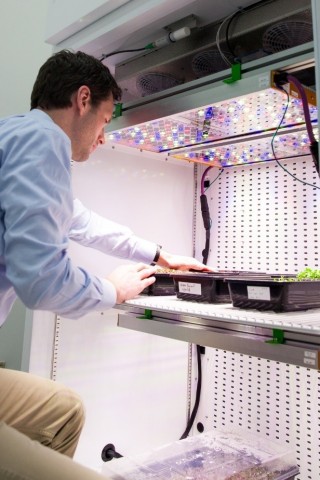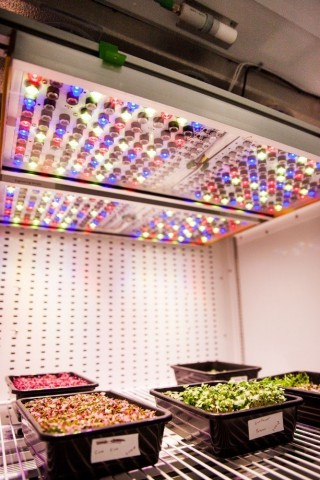Osrams smart horticulture lighting system prototype used in NASA ground research to help provide space crews with a reliable source of fresh food.
 NASA Taps Osram to Support Its Food Production Research
NASA Taps Osram to Support Its Food Production Research

Contributed by | Osram
Osram, a global high-tech lighting company, today announced it is providing the National Aeronautics and Space Administration (NASA) with a customized version of its proprietary connected horticulture research lighting system, Phytofy RL. The smart lighting software, coupled with a unique setup of connected grow light fixtures, will supplement the lighting technology used in NASA’s Food Production Research focused on production of salad-type crops for crews during space travel. All software, hardware and LEDs in Phytofy were developed by Osram. Osram has developed a broad portfolio of horticulture LEDs that irradiate the specific wavelengths needed for optimum growth of a wide variety of plants and flowers, allowing the light to be adapted specifically for the needs of various crops.
“Osram is developing smart, innovative lighting technologies that can improve food production in a variety of environments, even unique environments like space,” said Steve Graves, Strategic Program Manager of Urban & Digital Farming, Osram Innovation, Americas Region. “Many of the world’s coolest and most beneficial inventions have come from scientists at NASA over the past several decades, and to play a role in empowering further innovation through the use of our technologies is an honor. We are excited about the possibilities Phytofy RL will bring to a wide variety of horticulture applications, and our teams are excited to continue learning and refining its setup before ultimately bringing this exclusive solution to market within the next year.”
NASA was introduced to Osram through Hort Americas, which works closely with leading manufacturers to provide North American greenhouse growers, vertical farmers and researchers with the most technically advanced and cost-effective products to help them reach their yield, quality and project goals. Members of NASA's food production research team presented Hort Americas with a list of features they wanted from a lighting fixture, Hort Americas then used its network to help NASA team up with Osram to learn more about the Phytofy RL horticulture lighting technology, which is unlike anything commercially available.

Steve Graves, Strategic Program Manager of Urban & Digital Farming, Osram Innovation, Americas Region, observes microgreens in a growth chamber at NASA’s Kennedy Space Center. NASA is using Osram's Phytofy RL connected horticulture research lighting system for ground research focused on production of salad-type crops for crews during space travel.
Phytofy’s unique features include:
- A UV channel which provides researchers with the ability to add a brief UV light to see how plants react and change.
- More LEDs, which means a higher Photosynthetic Photon Flux (PPF). PPF measures light emission by calculating how many photons are coming out of the light every second. This is an important metric for plant researchers so they can determine the most efficient and effective light recipes.
- An Irradiance Map -- Researchers can see the irradiance using Osram software, so there is no need for them to measure irradiance separately before changing the light setting.
Osram’s smart horticulture lighting system is being piloted through a series of collaborations with universities and research labs around the world that are using the technologies and sharing insights. At NASA, Phytofy RL will allow researchers to easily adjust lighting conditions to optimize plant growth in various conditions and then replicate those settings in the Advanced Plant Habitat on the International Space Station, meeting the sophisticated needs of space food production. Installation of Phytofy RL within a growth chamber at Kennedy Space Center in Florida was completed recently, with plans to move the configuration to one or more of the Center’s walk-in plant grow rooms.

Osram's Phytofy RL connected horticulture research lighting system is comprised of smart lighting software coupled with a unique setup of connected grow light fixtures.
Via radiation with light of different wavelengths, the growth cycles of plants can be controlled and accelerated, allowing the plants to be harvested either more often or as required. Special light recipes optimize not only yield and growing time but also can increase the amount of vitamins and nutrients in the plant, and can enhance certain tastes and flavors. LEDs not only provide tailor-made bioactive lighting, but are also very efficient.
In addition to the company’s leadership with this particular system, Osram remains at the forefront of horticultural lighting advancements, offering everything from LED grow lights to complete solutions for vertical farms, hydroponic greenhouses, and small gardening systems. The company works closely with industry and research professionals to provide products and systems that optimize crop development, allowing reliable supply to industries such as retail food and flower markets, food processing facilities, and pharmaceuticals.
About OSRAM
OSRAM, based in Munich, is a leading global high-tech company with a history dating back more than 110 years. Primarily focused on semiconductor-based technologies, our products are used in highly diverse applications ranging from virtual reality to autonomous driving and from smart phones to smart and connected lighting solutions in buildings and cities. OSRAM uses the endless possibilities of light to improve the quality of life for individuals and communities. OSRAM’s innovations enable people all over the world not only to see better, but also to communicate, travel, work and live better. OSRAM has approximately 26,400 employees worldwide as of end of fiscal 2017 (September 30) and generated revenue of more than €4.1 billion. The company is listed on the stock exchanges in Frankfurt and Munich (ISIN: DE000LED4000; WKN: LED400; trading symbol: OSR).
The content & opinions in this article are the author’s and do not necessarily represent the views of AgriTechTomorrow
Comments (0)
This post does not have any comments. Be the first to leave a comment below.
Featured Product

